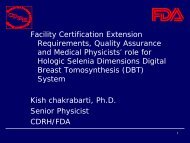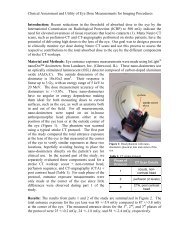Verification of Monitor Unit Calculations for Non-IMRT Clinical ...
Verification of Monitor Unit Calculations for Non-IMRT Clinical ...
Verification of Monitor Unit Calculations for Non-IMRT Clinical ...
Create successful ePaper yourself
Turn your PDF publications into a flip-book with our unique Google optimized e-Paper software.
Likelihood <strong>of</strong> Errors in a Clinic<br />
• Table 1 lists potential errors and their relative<br />
likelihood under 3 data transfer scenarios:<br />
– Manual – Everything entered by hand<br />
– Partial automation – Some or most<br />
parameters are transferred electronically,<br />
some manual entry/edit still required<br />
– Full Automation – All parameters transferred<br />
electronically to the R&V system<br />
• Potential <strong>for</strong> errors happening classified High,<br />
Medium, or Low<br />
Essential Aspects<br />
• Part <strong>of</strong> complete plan review<br />
– TG recommends per<strong>for</strong>ming prior to first<br />
treatment<br />
• Thorough commissioning and QA <strong>of</strong> MU<br />
verification system<br />
– Must have the same level <strong>of</strong> care in<br />
implementation and maintenance as the<br />
primary TPS<br />
• Independence<br />
Methods <strong>of</strong> <strong>Verification</strong><br />
• Calculational<br />
– Point comparison<br />
By far most common<br />
MU or Dose<br />
– Planar dose comparison<br />
– Volumetric dose comparison<br />
• Measurement<br />
Likelihood <strong>of</strong> Errors in a Clinic<br />
Independence<br />
• Independence <strong>of</strong> MU verification system<br />
– Different calculation method and/or program<br />
– Separate and independent beam data files<br />
May be based on same measured data<br />
– Download <strong>of</strong> patient-specific parameters from<br />
TPS to verification system allowed and<br />
encouraged, but must be confirmed<br />
• Independence <strong>of</strong> verifier<br />
– Per<strong>for</strong>med (preferably) or supervised by<br />
qualified physicist not involved in primary<br />
calculation<br />
Comparison Point Selection<br />
• Location, Location, Location<br />
• Point should be 2 cm from beam/block edge<br />
– Avoid penumbra effects<br />
• Point should be at least 1 cm downstream and<br />
lateral to large heterogeneities<br />
– Avoid disequilibrium effects<br />
• Single point common to all fields in a plan is<br />
preferred but not required.<br />
• Plan normalization point (ICRU point) preferred<br />
but not required.<br />
3/13/2013<br />
5


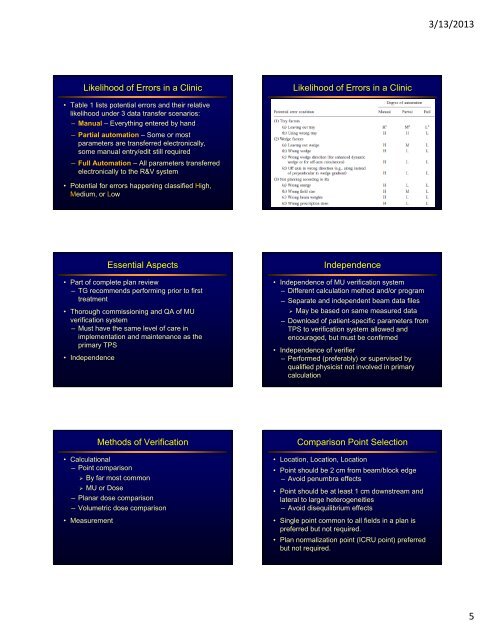






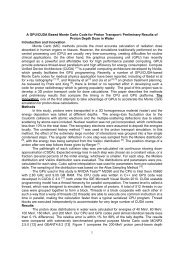
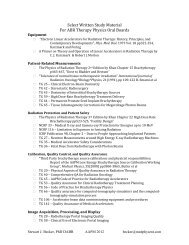

![SBRT&StereoscopicIGRT_2012 [Compatibility Mode]](https://img.yumpu.com/16889220/1/184x260/sbrtstereoscopicigrt-2012-compatibility-mode.jpg?quality=85)

